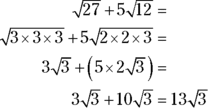Chapter 9
Algebra: Finding What X Really Means
IN THIS CHAPTER
 Working with bases and exponents
Working with bases and exponents
 Dealing with variables to solve algebraic expressions
Dealing with variables to solve algebraic expressions
 Digging deep into roots and radicals
Digging deep into roots and radicals
 Plotting points, lines, and slopes with coordinate geometry
Plotting points, lines, and slopes with coordinate geometry
 Manipulating functions and sequences
Manipulating functions and sequences
Algebra is a branch of mathematics that uses numbers, letters, and operations to represent the concepts and rules of mathematics. Through an understanding of these concepts and rules, you’re often able to use what you know (the information a question provides) to determine what you don’t know, such as the value of x. You’ve probably already solved lots of algebra questions in junior high and high school and perhaps even in your college courses. You just need a refresher to get your head back in the game.
This chapter reveals everything you need to know about algebra to be fully prepared for the test. It starts slowly with bases, exponents, and variables such as x and y and gradually moves on to complicated algebraic concepts. Although you’re free to skip around, you may want to start at the very beginning if you’re rusty with these concepts.
Using Bases and Exponents
Many GRE math questions require you to know how to work with bases and exponents. When you multiply a number repeatedly by itself, you raise that number to a certain power; for example, 3 to the power of 4, or 34, is  . In this example, 3 is the base, and 4 is the exponent. The exponent simply tells you how many times to multiply the base (number) by itself. Here are a few more examples:
. In this example, 3 is the base, and 4 is the exponent. The exponent simply tells you how many times to multiply the base (number) by itself. Here are a few more examples:
Remember the following rules when working with bases and exponents:
- Any number to the zero power equals 1.

- Any number to a negative exponent is the reciprocal of that number to its positive exponent.

 A number with a negative exponent isn’t negative. When you flip it, you get the reciprocal, and the negative goes away. Like this:
A number with a negative exponent isn’t negative. When you flip it, you get the reciprocal, and the negative goes away. Like this: 
- When you raise 10 to a power, you get 1 followed by the number of zeros equal to that power.



Because
 ,
,  is
is  , which equals 50,000.
, which equals 50,000. - To multiply like bases, add the exponents.



 You can’t multiply different bases. For example,
You can’t multiply different bases. For example,  stays
stays  , and
, and  stays
stays  .
. - To divide like bases, subtract the exponents.



 Did you look at the second example,
Did you look at the second example,  , and think the answer is
, and think the answer is  ? Falling into the trap of dividing exponents rather than subtracting them can happen, especially when you see numbers that just beg to be divided, such as 8 and 4. A common mistake, but don’t let it get you.
? Falling into the trap of dividing exponents rather than subtracting them can happen, especially when you see numbers that just beg to be divided, such as 8 and 4. A common mistake, but don’t let it get you. - Multiply the exponents of a base inside and outside of parentheses.



 This is true even with negative exponents:
This is true even with negative exponents: 


- To add or subtract like bases with like powers, add or subtract the numerical coefficients of the bases. The numerical coefficient is the number to the left of the base; for example, in 31x3, 31 is the numerical coefficient.


 You can’t add or subtract the numerical coefficients when the bases are different. For example,
You can’t add or subtract the numerical coefficients when the bases are different. For example,  stays the same and does not become
stays the same and does not become  ,
,  , or
, or  . Furthermore, you can’t add or subtract like bases with different exponents. For example,
. Furthermore, you can’t add or subtract like bases with different exponents. For example,  isn’t equal to
isn’t equal to  ,
,  , or
, or  . It stays
. It stays  . The bases and exponents must be the same for you to add or subtract the terms.
. The bases and exponents must be the same for you to add or subtract the terms.
To make sure you’re comfortable with the variations, try these Quantitative Comparison (QC) questions with bases and exponents. (In a QC question, you compare the contents in two columns: More on this in Chapter 13.)
For all QC questions on the GRE, you choose from the following answer choices:
 Quantity A is greater.
Quantity A is greater.
 Quantity B is greater.
Quantity B is greater.
 The two quantities are equal.
The two quantities are equal.
 The relationship cannot be determined from the information given.
The relationship cannot be determined from the information given.


Remember that when you divide, you subtract the exponents, so  , regardless of the value of x. The correct answer is Choice (C).
, regardless of the value of x. The correct answer is Choice (C).


Because you multiply exponents together when you take an exponent to a higher power, the two quantities are the same, regardless of x:  The correct answer is Choice (C).
The correct answer is Choice (C).


Because you don’t know the value of x, you can’t tell which quantity is greater. You may think that anything to the 12th power is a large number, making Choice (A) the correct answer, but you need to know more about x. If x equals 2, then you’d be right. If x equals  , you’d be wrong. This is an easy one to fall for. See Chapter 13 for more on trying different values of x for different results. The correct answer is Choice (D).
, you’d be wrong. This is an easy one to fall for. See Chapter 13 for more on trying different values of x for different results. The correct answer is Choice (D).


Because you don’t know what x is, as in the preceding question, try different values for x to see which quantity is greater. If you selected Choice (C), you fell for the trap. The correct answer is Choice (D).


Because you don’t know what x or y is, you can’t tell which quantity is greater. The correct answer is Choice (D).
Working with Math Operators and Functions
You may encounter questions based on math operators and functions on the GRE. The approach is simple: Plug a number in for the variable. The math itself is always easy. The trick is knowing how to set up the equation. This section explains how to set up the equations to do the math and arrive at the answer.
Substituting for the variable in the math operator
You see a problem with a strange symbol. It may be a triangle, a star, or a circle with a dot, as in the following example. You’ve never seen it before, and you’re not sure what it means. It’s probably a math operator, such as +, –, ×, or ÷, but it’s a new one that the GRE uses just for this one math question. Don’t worry — the GRE always tells you what the symbol means (or allows you to figure it out).
The symbol may be part of an equation, like this:

A question follows the explanation, like this:

Here’s how you solve it:
-
Substitute the numbers for the letters:
For this problem, substitute 3, 4, and 5 for a, b, and c, respectively.

- Solve the equation:

The GRE keeps things interesting with variations like this:
 If
If  , then
, then 
To solve, substitute –4 for x:

Then solve the equation for your answer:

Substituting for the variable in the function
You can spot a function question by the distinctive  . The letters aren’t always f and x (for example,
. The letters aren’t always f and x (for example,  is common), but the setup is always the same. You may see a problem like this:
is common), but the setup is always the same. You may see a problem like this:

 . Solve for
. Solve for  .
.
To solve, substitute the number in parentheses for the letter in parentheses (in this case, plug in 2 for x):

Try another one:

 . Solve for
. Solve for  .
.
Just substitute the 10 for the x:

Revisiting Algebra
To correctly answer algebra questions on the GRE, you must be able to
- Solve for x in a simple equation.
- Use the FOIL method to multiply binomials. (Refer to the later section “Multiplying with the FOIL method” for details.)
- Factor a quadratic equation to solve for x.
The following sections review the basics of algebra that you need for the GRE.
Solving for x
To solve for x, or any other letter, in a simple equation, follow these steps:
- Move all the x’s to the left side of the equation.
- Move all the numbers to the right side of the equation.
- Divide both sides of the equation by the number in front of the x.
Now try it with this equation:

-
Move all the x’s to the left side of the equation.
Anything on the right side that’s tied to an x, in this case 9x, is subtracted — from both sides. The 9x gets cancelled from the right and subtracted from the left.

-
Move all the numbers to the right side of the equation.
This is just like the previous step, only you’re subtracting the number, in this case 7, from both sides. The 7 is cancelled from the left and subtracted from the right.

-
Divide both sides by the number next to the x.
This number near the x is also called the coefficient.

Just to be sure, plug the 2 back into the original equation to make sure it works:

 Solve for x:
Solve for x:

 7
7
 8
8
 10
10
 12
12
 14
14
You could solve for x, but I wouldn’t. Instead, start with the answer choice number that’s easiest to work with, in this case probably 10. Then it goes like this:

See? Almost too easy. Solving for x would have been a nightmare. Correct answer: Choice (C).
Multiplying with the FOIL method
When multiplying any number by a binomial (a value expressed as the sum or difference of two numbers), you use the distributive property, which means you multiply all the values inside the parentheses by the multiplier to the left of the parentheses. For example:

When multiplying two binomials, such as  , you also use the distributive property. Basically, you multiply everything in one set of parentheses by everything in the other set of parentheses and then add up all the results. This is also known as the FOIL method, which stands for First, Outer, Inner, Last. Try it with this equation:
, you also use the distributive property. Basically, you multiply everything in one set of parentheses by everything in the other set of parentheses and then add up all the results. This is also known as the FOIL method, which stands for First, Outer, Inner, Last. Try it with this equation:

- Multiply the First variables.

- Multiply the Outer variables.

-
Multiply the Inner variables.
 (which is the same as ab).
(which is the same as ab). - Multiply the Last variables.

-
Combine like terms.
 (Here, the –ab and +ab cancel out.)
(Here, the –ab and +ab cancel out.)
Like terms are two or more terms with the same variable(s) and exponent. For example, 3x3 and 2x3 are like terms, and you may combine them as follows:  . You can’t, however, combine 3x3 and 3y3 or 3x3 and 3x5, because in the first case, the variables differ, and in the second case, the exponents differ.
. You can’t, however, combine 3x3 and 3y3 or 3x3 and 3x5, because in the first case, the variables differ, and in the second case, the exponents differ.
Try another one: 
- Multiply the First terms.

- Multiply the Outer terms.

- Multiply the Inner terms.
 (which is the same as ab)
(which is the same as ab) - Multiply the Last terms.

-
Combine like terms for the final answer.
 , so
, so  .
.
-

You can also prove this equation with FOIL:
 .
. - Multiply the First terms:
 .
. - Multiply the Outer terms:
 .
. - Multiply the Inner terms:
 (which is the same as –ab).
(which is the same as –ab). - Multiply the Last terms:
 .
. - Combine like terms for the final answer:
 , so
, so  .
.
 The only time the middle term cancels out is when the binomials are the same except one has a plus and the other a minus, such as
The only time the middle term cancels out is when the binomials are the same except one has a plus and the other a minus, such as  , resulting in a perfect square minus a perfect square:
, resulting in a perfect square minus a perfect square:  . When a question has a perfect square minus a perfect square, you can quickly do the reverse and factor it:
. When a question has a perfect square minus a perfect square, you can quickly do the reverse and factor it:  . More on factoring in the next section.
. More on factoring in the next section. - Multiply the First terms:
-

You can prove this equation using FOIL:
 .
. - Multiply the First terms:
 .
. - Multiply the Outer terms:
 .
. - Multiply the Inner terms:
 (which is the same as ab).
(which is the same as ab). - Multiply the Last terms:
 .
. - Combine like terms for the final answer:
 , so
, so  .
.
- Multiply the First terms:
-

You can also prove this equation using FOIL:
 .
. - Multiply the First terms:
 .
. - Multiply the Outer terms:
 .
. - Multiply the Inner terms:
 (which is the same as –ab).
(which is the same as –ab). - Multiply the Last terms:
 .
. - Combine like terms for the final answer:
 , so
, so  .
.
Note that the b2 at the end is positive, because it’s from a negative times a negative.
- Multiply the First terms:
Factoring back out
As often as you FOIL terms on the GRE, you also factor them, which is the opposite of FOILing. Factoring takes an algebraic expression from its final form back to its original form of two binomials. You perform this operation when an equation contains x2 to find the two possible values of x.
Given  , what are the two possible values of x? Factor it out one step at a time:
, what are the two possible values of x? Factor it out one step at a time:
- Draw two sets of parentheses.

-
Fill in the First terms.
To get x2, the first terms have to be x and x.

-
Fill in the Last terms.
You need two numbers that equal –12 when multiplied and –4 when added. Start with the multiplied number, in this case –12: You have
 ,
,  , and
, and  . Keep in mind that one of these terms is negative, for the –12, so which two numbers add up to –4? After a few tries, you find that –6 and + 2 do the trick: Multiplied, they equal –12, and added, they equal –4. Now you can complete the equation:
. Keep in mind that one of these terms is negative, for the –12, so which two numbers add up to –4? After a few tries, you find that –6 and + 2 do the trick: Multiplied, they equal –12, and added, they equal –4. Now you can complete the equation: 
 Whether you write it as
Whether you write it as  or
or  doesn’t matter. These expressions are multiplied, so they can be in either order.
doesn’t matter. These expressions are multiplied, so they can be in either order.Now solve for x as two separate equations:
 and
and  , for x values of 6 and – 2. Note that x doesn’t equal both 6 and –2; it equals one or the other. That’s why the question is phrased, “What are the two possible values for x?”
, for x values of 6 and – 2. Note that x doesn’t equal both 6 and –2; it equals one or the other. That’s why the question is phrased, “What are the two possible values for x?”
Dealing with Square Roots and Radicals
You’re likely to see math problems on the GRE that include square roots or radicals. A square root is a number that’s multiplied by itself for a result; for example, 3 is the square root of 9 (because  ). A radical is another way of expressing a square root; for example, the square root of 9 may be represented as
). A radical is another way of expressing a square root; for example, the square root of 9 may be represented as  . Though higher-level roots exist in math, the square root is the only root you see on the GRE.
. Though higher-level roots exist in math, the square root is the only root you see on the GRE.
The following sections point out the math problems you may encounter on the exam related to roots and radicals. But first, you need to know how to simplify them.
Simplifying square roots and radicals
When possible, simplify radicals to get rid of them. Simplifying basically means reducing the radical to its most manageable form, often getting rid of the radical altogether. To simplify a radical, factor the number inside and pull out pairs of factors. Here are a few examples:
In some cases, part of the radical remains, but you can still reduce it to make the number easier to work with. In these problems, the GRE simply expects you to reduce the radical as far as you can, and the correct answer choice will typically include a radical. Here’s an example of a radical that you can’t reduce to an integer but you can simplify:

In this example, the square root of 100 is 10, so the 10 comes out of the radical. The 3, however, stays inside the radical, and the two numbers (10 and  ) are multiplied for a result of
) are multiplied for a result of  .
.
However, the question may ask what the number is “approximately equal to” or “closest to,” in which case you estimate the radical, as explained next.
Estimating the radical
When asked to estimate  , consider that it falls between
, consider that it falls between  and
and  . Because
. Because  and
and  ,
,  is between these and roughly 3.5. Knowing that the answer is between 3 and 4 is good enough to answer almost any GRE question. You never have to estimate the value more precisely than that.
is between these and roughly 3.5. Knowing that the answer is between 3 and 4 is good enough to answer almost any GRE question. You never have to estimate the value more precisely than that.
Adding and subtracting radicals
To add and subtract numbers with radicals, adhere to the following two rules:
- You can add or subtract similar radicals: Just add or subtract the number in front of the radical.


 This works just like adding or subtracting numbers with x:
This works just like adding or subtracting numbers with x:  and
and  .
. - You can’t add or subtract different radicals:
 stays the same, just like
stays the same, just like  stays the same.
stays the same.
If the radicals aren’t the same, you may still be able to add or subtract them. Try to simplify one radical to make it similar to the other:

 Try these out:
Try these out:
Here are the answers:
Multiplying and dividing numbers with radicals
To multiply and divide numbers with radicals, stick with these two rules:
- Put all the numbers inside one radical and then multiply or divide the numbers.


- If numbers are in front of the radicals, multiply or divide them separately. Because the order doesn’t matter when multiplying, move the pieces around to make them easier to multiply.

Dividing works pretty much the same way:
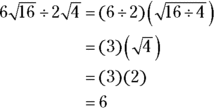










 1,221
1,221
You know that  and that
and that  , so the answer is
, so the answer is  . This one is straight multiplication. The correct answer is Choice (D).
. This one is straight multiplication. The correct answer is Choice (D).
Working radicals from the inside out
When you see an operation under the radical, work it first, and then take the square root of the answer.

First, simplify  . The common denominator is 9, making the numerators 1 and 3, resulting in
. The common denominator is 9, making the numerators 1 and 3, resulting in  . Now take the square roots of the top and bottom, separately:
. Now take the square roots of the top and bottom, separately:

And the answer is  .
.
Plotting It Out with Coordinate Geometry
Coordinate geometry is where algebra and geometry meet — a method of describing points, lines, and shapes by using algebra. It all happens on a piece of graph paper, also known as the coordinate plane.
The coordinate plane, also known as the x-y rectangular grid, is a two-dimensional area defined by a horizontal x-axis and a vertical y-axis that intersect at a point of origin labeled (0, 0). Each point is labeled using an ordered pair (x, y) with the first number in the parentheses indicating how far to the right or left of (0, 0) the point is and the second number indicating how far above or below (0, 0) the point is. For example, this point has an x-value of 2 and a y-value of 1, for the coordinates (2, 1):

© John Wiley & Sons, Inc.
The following sections provide need-to-know information for solving the coordinate geometry questions you may encounter on the GRE.
Solving common problems
To answer common questions related to coordinate geometry, you need to know a few key steps.
Distance between two points
If you’re asked to find the distance between two points on the grid, you can use the distance formula, which is based on the Pythagorean theorem (see Chapter 10). In a right triangle, using the lengths of the two shorter sides, the formula lets you determine the length of the longest side (the hypotenuse); in equation form,  , where a and b are the lengths of the shorter sides and c is the length of the longest side.
, where a and b are the lengths of the shorter sides and c is the length of the longest side.
In coordinate geometry, you use this formula along with the coordinates of two points to specify the lengths of the sides. Given two points, one with coordinates (x1, y1) and the other with coordinates (x2, y2), the length of one of the shorter sides is  , and the length of the other shorter side is
, and the length of the other shorter side is  .
.
The distance formula is basically drawing a right triangle from the points on the grid and using the Pythagorean Theorem to find the hypotenuse.
Suppose you’re asked to calculate the distance between two points with coordinates (1, 2) and (7, 10). On the coordinate system, the right triangle would look like the following drawing; the length of one short side would be  , and the length of the other short side would be
, and the length of the other short side would be  .
.

© John Wiley & Sons, Inc.
Plug these lengths into the distance formula for a distance of 10:

The distance formula provides another approach for answering questions such as these. With the coordinates of the two points, you can use the following formula to calculate the distance between the two points:
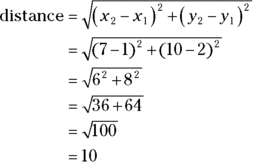
 Find the distance from (9, 4) to (8, 6).
Find the distance from (9, 4) to (8, 6).
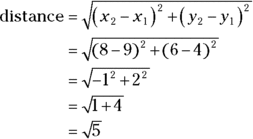
Slope formula
The slope of a line is defined as “rise over run” — the distance the line rises compared to its horizontal distance. To find the slope of the line that goes through the points (1, 2) and (7, 10) (from the preceding section), note that the line rises 8 and runs 6. The slope is  , which you can reduce to
, which you can reduce to  .
.
Another way to calculate the slope of a line that goes through the points (x1, y1) and (x2, y2) is to use the slope formula:

 What is the slope of the line connecting the points (–1, –2) and (4, 6)?
What is the slope of the line connecting the points (–1, –2) and (4, 6)?
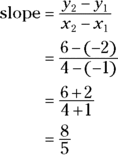
The linear equation
A linear equation is any equation with x and y and no exponents, such as  . The slope-intercept form basically shows it as solved for y, such as
. The slope-intercept form basically shows it as solved for y, such as  , or
, or  . This is called the slope-intercept form because it shows the slope and y-intercept right there in the equation: m is the slope and b is the y-intercept (the point at which the line representing the equation intersects the y-axis).
. This is called the slope-intercept form because it shows the slope and y-intercept right there in the equation: m is the slope and b is the y-intercept (the point at which the line representing the equation intersects the y-axis).
Questions on the GRE that involve the slope-intercept form often provide you with the coordinates of a point through which the line passes and require that you calculate the y-intercept. For example, the line  passes through point (4, 15). At what point does the line cross the y-axis? To get the answer, you plug in 4 for x and 15 for y and then solve the equation:
passes through point (4, 15). At what point does the line cross the y-axis? To get the answer, you plug in 4 for x and 15 for y and then solve the equation:

So the line crosses the y-axis at the point (–13, 0).
You can also use the slope-intercept form to find the slope of a line when given its y-intercept and the coordinates of any point on the line. Suppose a line crosses the y-axis at  and goes through the point (4, 13), and you need to determine its slope. Simply plug the given values into the slope-intercept form:
and goes through the point (4, 13), and you need to determine its slope. Simply plug the given values into the slope-intercept form:
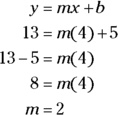
Midpoint formula
If you’re asked to find the midpoint of a line segment defined by the coordinates of two points on the graph, you can draw the right triangle or use the midpoint formula:

In this formula, (x1, y1) are the coordinates of one of the line segment’s endpoints, and (x2, y2) are the coordinates of the other endpoint.
Working with linear equations
Linear equations can be in different forms, as long as there are no exponents. (An exponent curves the line.) Given the equation  , find an ordered pair (the x-y coordinates of a point) that makes the equation true. To test this, plug in values for x and y, and make sure the equation works. In this case, the ordered pairs (0, 8), (6, 4), and (–3, 10) make the equation true.
, find an ordered pair (the x-y coordinates of a point) that makes the equation true. To test this, plug in values for x and y, and make sure the equation works. In this case, the ordered pairs (0, 8), (6, 4), and (–3, 10) make the equation true.

© John Wiley & Sons, Inc.
You may also encounter linear equations in a different format. For example, instead of  , you may see
, you may see  or
or  . Regardless of how the equation is presented, you can usually find two points on the line by setting x equal to 0 and solving for y and then setting y equal to 0 and solving for x. Use this method to find two ordered pairs for the equation
. Regardless of how the equation is presented, you can usually find two points on the line by setting x equal to 0 and solving for y and then setting y equal to 0 and solving for x. Use this method to find two ordered pairs for the equation  . Here’s y if
. Here’s y if  :
:

So one point is (0, 8). And here’s x if  :
:

And the other point is (12, 0).
 Identify the (x, y) coordinates that make the equation
Identify the (x, y) coordinates that make the equation  true.
true.
Select all correct answers.
 (0, 9)
(0, 9)
 (6, 1)
(6, 1)
 (9, –6)
(9, –6)
 (5, 2)
(5, 2)
 (6, –1)
(6, –1)
 (3, –2)
(3, –2)
To solve this problem, substitute the coordinates of each answer into the equation, and make sure the equation is true. You’re looking for the x and y values that make the equation equal to 27:
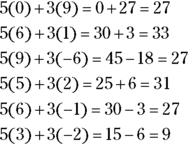
The correct answers are Choices (A), (C), and (E).
Solving simultaneous equations
A linear equation has endless solutions, because for every value of x, there’s a corresponding value of y. Simultaneous equations refer to two linear equations depicting lines that cross, which means there is a single value for x and one for y where the lines cross. These single values for x and y are called the solutions to the equation. There are two ways to find this: addition and substitution.
Addition method
The addition method (also known as the elimination method) is easy and works best for simpler equations. For example, say you’re solving this:


Make sure the x’s and y’s (or whichever letters are in the equations), the numbers, and the equal signs are lined up, then add (or subtract) to cancel one unknown and solve for the other.

Now place the newly-discovered value of x into either original equation to find the value of y. You should get the same value of y from both equations.
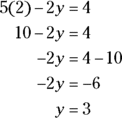
If you were to graph the equations, you would see that the (x, y) value of (2, 3) is where the two lines meet.

© John Wiley & Sons, Inc.
Here, try and fit these together for the solutions to the equations:
You’re sure to encounter these on the GRE, so make sure you’re comfortable with these variations on the theme.
1. In this one, you don’t add the equations: you subtract them:

Armed with x as 4, plug it back in for y. Here, I use the first equation:

2. Wait — what can you add or subtract to cancel something out? Set it up so that you can do that: Multiply the second equation by either 2 to cancel the b’s or 3 to cancel the a’s. Either way is fine. Start with this:

And it becomes this:

Then it’s business as usual:

All that for  . Place it back into one of the original equations:
. Place it back into one of the original equations:

And the lines cross at  , because a linear equation doesn’t always use x and y.
, because a linear equation doesn’t always use x and y.
Substitution method
The other method is substitution, which has more steps but works better for some complicated equations. Just follow these steps:
- In one of the equations, solve for the first unknown in terms of the second unknown.
- Substitute the result from Step 1 for the first unknown in the other equation and solve for the second unknown.
- Plug the value for the second unknown into either equation and solve for the first unknown.
It’s easier than it sounds. Try it out on this example:


In this example, the second equation is the easier of the two to start with. Solve for x in terms of y:

Now substitute  for x in the first equation and solve for y:
for x in the first equation and solve for y:
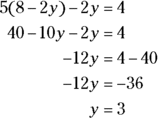
Finally, plug the value for y into one of the original equations to find the value of x:
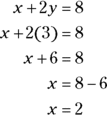
The answer is (2, 3).
The addition method is usually faster and simpler, especially when everything lines up (the x’s, the y’s, and the equal signs). If the x is on the left of the equal sign in one equation and on the right side in the other, you may want to use substitution. Don’t sweat this choice though: Both methods work well and fast and give you the same result.
You’ll find simultaneous equations in word problems, which I cover more in Chapter 11. Here’s an example of a problem where substitution works nicely:
 Andy is 5 years older than Betsy. If he’ll be twice her age in 3 years, how old are Andy and Betsy now?
Andy is 5 years older than Betsy. If he’ll be twice her age in 3 years, how old are Andy and Betsy now?
 7 and 2
7 and 2
 6 and 3
6 and 3
 8 and 5
8 and 5
 10 and 2
10 and 2
 10 and 5
10 and 5
First set up the equations. Remember that words like is, are, and will be serve as equal signs. “Andy is 5 years older than Betsy” becomes  , while “he’ll be twice her age in 3 years” becomes
, while “he’ll be twice her age in 3 years” becomes  . Only the GRE could turn kids into linear equations. Well, really I did this. Anyway, because
. Only the GRE could turn kids into linear equations. Well, really I did this. Anyway, because  from the first equation, substitute
from the first equation, substitute  for a in the second equation, like this:
for a in the second equation, like this:

Now solve for b:

So if Betsy’s two years old (awww …), use 2 for b in the first equation to find Andy’s age:

I wrote the kids young to make the math easier. Correct answer: Choice (A).
Circling back: Graphed circles
A graphed circle is a circle drawn on the x/y plane from an equation. The equation is like a contorted linear equation — there’s an x and a y, but they’re twisted and squared instead of a nice, simple  . Don’t worry though — in the classroom, the teachers vary the heck out of the graphed circle, but on the GRE, there’s only one flavor. This is the equation for the graphed circle:
. Don’t worry though — in the classroom, the teachers vary the heck out of the graphed circle, but on the GRE, there’s only one flavor. This is the equation for the graphed circle:

In this equation, h and k are the x and y values of the center, while r is the radius. The way you remember this is that the x and y values of the center become negative (or positive, if they’re already negative,) and the radius is squared. Say you have a circle where the (x, y) coordinates of the center are (3, –2) and the radius is 5.
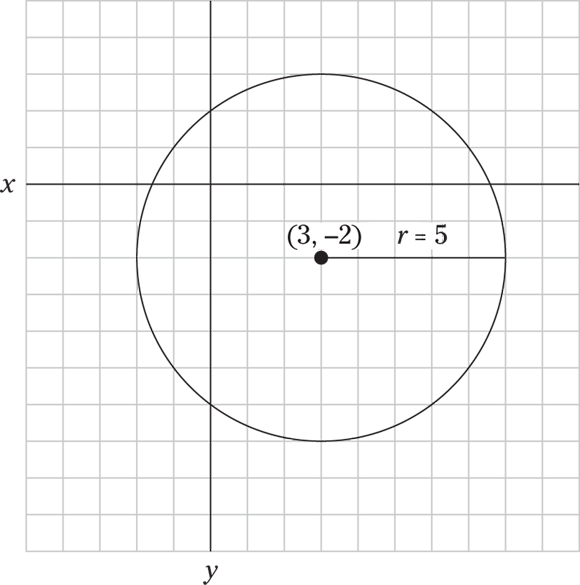
© John Wiley & Sons, Inc.
The equation of this circle is thus  . It also may appear as
. It also may appear as 
 , with the radius squared.
, with the radius squared.
 A circle is drawn in the x/y coordinate grid. If the radius is 3 and the (x, y) coordinates of the center are (–2.5, 0.5), which of the following is the equation for the circle?
A circle is drawn in the x/y coordinate grid. If the radius is 3 and the (x, y) coordinates of the center are (–2.5, 0.5), which of the following is the equation for the circle?










Knowing the equation of the circle is  , just plug in –2.5 for x, 0.5 for y, and 3 for r. Watch out for trap answers where x and y are the wrong sign or r isn’t squared. Correct answer: Choice (E).
, just plug in –2.5 for x, 0.5 for y, and 3 for r. Watch out for trap answers where x and y are the wrong sign or r isn’t squared. Correct answer: Choice (E).
Recognizing Patterns in Sequential Terms
A GRE sequential terms problem has you interpret a numeric pattern from an equation. The term is indicated with a letter, such as a, and counted with a subscript number, such as: a1, a2, a3, a4, a5, …, an.
You’re typically given one value for a, such as a1 = 10. The 1 in a1 means “the first a,” and the statement tells you that the first a has a value of 10. Be sure not to confuse the subscript number, in this case the 1 in a1, with the value of that particular a, in this case 10.
Next, you’re given an equation that describes the relationship between the sequential terms — in other words, the value of the next a — such as

Though the value of n (the subscript of a) changes, it has only one value at a time in the equation. For example, if  , then
, then  . The equation can thus be rewritten as this:
. The equation can thus be rewritten as this:

Don’t get caught up in the math. Under all that subscript, what it tells you is simple. Each a is 3 more than the previous a. The second a, which is  , is 3 more than the first a, which is
, is 3 more than the first a, which is  .
.
The next iteration of the equation, with 1 added to n again, looks like this:

It tells you that the third a,  , is 3 more than the second a,
, is 3 more than the second a,  . In other words, if
. In other words, if  , then
, then  ,
,  , and so forth. That’s the pattern from the equation. The question is then based on this pattern. For example, “What is the value of a6?” Just keep adding 3 until you reach the sixth a:
, and so forth. That’s the pattern from the equation. The question is then based on this pattern. For example, “What is the value of a6?” Just keep adding 3 until you reach the sixth a:

 In the sequence
In the sequence  , for all positive integers b and n, where
, for all positive integers b and n, where  , what is the value of b5?
, what is the value of b5?
 20
20
 16
16
 8
8
 4
4
 0
0
Start with the equation  , which translates to English as, “The next b is 4 less than this b.” If this b, or
, which translates to English as, “The next b is 4 less than this b.” If this b, or  , is 12, then
, is 12, then  is 8, and
is 8, and  is 4. Correct answer: Choice (D).
is 4. Correct answer: Choice (D).
 In the sequence
In the sequence  , for all positive integers h and m, where
, for all positive integers h and m, where  , what is the value of m when
, what is the value of m when  ?
?
 4
4
 2
2
 0
0
 –1
–1
 –2
–2
Start with the equation  , which is GRE-speak for “The previous h is 5 less than this h.” Instead of counting the little numbers up, you count them down. If this h, or
, which is GRE-speak for “The previous h is 5 less than this h.” Instead of counting the little numbers up, you count them down. If this h, or  , is 8, then the previous h,
, is 8, then the previous h,  is 3, and the one before that,
is 3, and the one before that,  , is –2. But there’s a twist: It doesn’t want the value of h. It wants the value of m when
, is –2. But there’s a twist: It doesn’t want the value of h. It wants the value of m when  . That’s the GRE — it does stuff like this. Correct answer: Choice (A).
. That’s the GRE — it does stuff like this. Correct answer: Choice (A).
Functioning with f(x)
A function is a linear equation, like  . Only instead of y, the GRE uses f(x), like this:
. Only instead of y, the GRE uses f(x), like this:  . The f(x) represents the resulting y value, and you plug in a value for x by substituting the number in the f(x). For example, if
. The f(x) represents the resulting y value, and you plug in a value for x by substituting the number in the f(x). For example, if  , then
, then  , and
, and  . Note that the GRE may use other letters, such as g(h).
. Note that the GRE may use other letters, such as g(h).
Questions on the GRE that involve f(x) typically give you an equation where you plug in the values for x for the answer. Here’s how you get started:
- Plug the value of x from the f(x) into each x in the equation.
- Watch for variations in the f(x) or the equation.
Here are some examples of variations of a single f(x) equation:
 When
When  , what is the value of
, what is the value of  ?
?
Just plug in 3 for x in the equation:

When  , what is the value of
, what is the value of  ?
?
First find the value of  :
:

Now that you know what  is, double it for
is, double it for  :
:

 When
When  , what are the two values of x when
, what are the two values of x when  ?
?
Substitute 48 for the entire  :
:
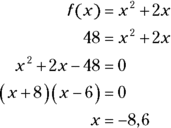
See? That’s all there is to it. Now try this one:
 The function g is defined as
The function g is defined as  for all real numbers h. If j is a number such that
for all real numbers h. If j is a number such that  , which two of the following could be the number j?
, which two of the following could be the number j?
Indicate two such numbers.
 –5
–5
 –3
–3
 –1
–1
 2
2
 4
4
 6
6
Start with finding what g(h) is when it equals 10:
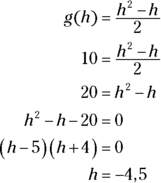
Now here’s the twisty part. h may be –4 and 5, but the question asks for j, which is equal to –h. Correct answers: Choices (A) and (E).



 and
and  .
. , you know that x equals 5 or – 5, but not both. These two possible values are also called solutions. If
, you know that x equals 5 or – 5, but not both. These two possible values are also called solutions. If  , the two possible values (or solutions) are 3 and –3, but the value of y is either 3 or –3: not both.
, the two possible values (or solutions) are 3 and –3, but the value of y is either 3 or –3: not both. , then boom it’s
, then boom it’s  . If the exam gives you
. If the exam gives you  , don’t think about it, just make it
, don’t think about it, just make it  . You may see these equations later on in this chapter … just sayin’ …
. You may see these equations later on in this chapter … just sayin’ … , as in
, as in  , but that almost never happens on the GRE, so there’s no need to cover it here. The equations that you factor will almost always be very simple: The GRE is testing whether you understand the concept, not whether you can go knee-deep in the math.
, but that almost never happens on the GRE, so there’s no need to cover it here. The equations that you factor will almost always be very simple: The GRE is testing whether you understand the concept, not whether you can go knee-deep in the math. , never
, never  ), because a negative number multiplied by itself results in a positive answer. If you see a square root on a negative number, recognize that this is not a real number, which means the equation with the number won’t work.
), because a negative number multiplied by itself results in a positive answer. If you see a square root on a negative number, recognize that this is not a real number, which means the equation with the number won’t work.  is not – 5, because the square root is from the same number multiplied by itself (squared), and – 5 times itself is + 25.
is not – 5, because the square root is from the same number multiplied by itself (squared), and – 5 times itself is + 25.



 , look at the answer choices. Typically,
, look at the answer choices. Typically,  will be waiting in the list, and you can leave your answer at that.
will be waiting in the list, and you can leave your answer at that. . Don’t worry about the other radicals, but knowing this one can get you out of a pinch.
. Don’t worry about the other radicals, but knowing this one can get you out of a pinch.


